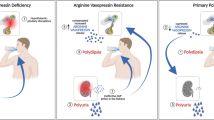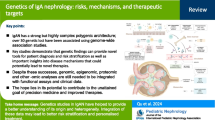Abstract
Ménière’s disease (MD) is an inner ear disorder, characterized by a burden of symptoms, probably arising from the interplay of genetic and environmental factors. In this brief review, we consider the role of ion channels and transporters in the pathophysiology of MD, focusing on genetic and biohumoral aspects. Pathophysiological mechanisms related to altered concentrations of ions in the endolymph include altered osmotic pressure leading to hydrops and/or immunomodulatory effects of K+ and Endogenous Ouabain (EO) concentrations in the inner ear. Aquaporins 1–5 (AQPs) have been found in the inner ear; AQP2 is the only isoform controlled by a hormone, namely, vasopressin (antidiuretic hormone, ADH). Genetic studies on AQPs have provided inconclusive results. Recently, two genetic polymorphisms have been associated with MD: rs3746951, a missense variant (Gly180Ser) in the Salt-Inducible Kinase-1 (SIK1) gene and rs487119, an intronic variant of gene SLC8A1 coding for a Na+,Ca++ exchanger (NCX-1). EO is a hormone released by the midbrain and adrenal glands. It controls the constitutive capacity of modulating Na+,K+-ATPase activity. Higher plasma levels of EO have been found in MD subjects compared to a control group.
Similar content being viewed by others
References
Lopez-Escamez JA, Carey J, Chung WH, Goebel JA, Magnusson M, Mandalà M et al (2015) Diagnostic criteria for Ménière's disease. J Vestib Res 25:1–7. https://doi.org/10.3233/VES-150549
Requena T, Espinosa-Sanchez JM, Cabrera S, Trinidad G, Soto-Varela A, Santos-Perez S, Teggi R, Perez P, Batuecas-Caletrio A, Fraile J, Aran I, Martin E, Benitez J, Perez-Fernandez N, Lopez-Escamez JA (2014) Familial clustering and genetic heterogeneity in Meniere’s disease. Clin Genet 85(3):245–252. https://doi.org/10.1111/cge.12150
Morrison AW (1995) Anticipation in Meniere's disease. J Laryngol Otol 109:499–502. https://doi.org/10.1017/S0022215100130567
Frejo L, Giegling I, Teggi R, Lopez-Escamez JA, Rujescu D (2016) Genetics of vestibular disorders: pathophysiological insights. J Neurol 263(Suppl 1):45–53. https://doi.org/10.1007/s00415-015-7988-9
Lang F, Vallon V, Knipper M, Wangemann P (2007) Functional significance of channels and transporters expressed in the inner ear and kidney. Am J Physiol Cell Physiol 293:1187–1208. https://doi.org/10.1152/ajpcell.00024.2007
Candreia C, Schmuziger N, Gurtler N (2010) Molecular analysis of aquaporin genes 1 to 4 in patients with Ménière’s Disease. Cell Physiol Biochem 26:787–792. https://doi.org/10.1159/000322346
Lopes de Carvalho K, Sartorato EL, da Silva-Costa SM, de Macedo Adamov NS, Ganança FF (2016) Ménière's disease: molecular analysis of aquaporins 2, 3 and potassium channel KCNE1 genes in Brazilian patients. Otol Neurotol 37:1117–1121. https://doi.org/10.1097/MAO.0000000000001136
Mallur PS, Weisstuch A, Pfister M et al (2010) Aquaporin-2 and -4: single nucleotide polymorphisms in Ménière’s disease patients. Audiol Med 8:18–23. https://doi.org/10.1159/000322346
Friedmann I, Fraser GR, Froggatt P (1966) Pathology of the ear in the cardioauditory syndrome of Jervell and Lange–Nielsen (recessive deafness with electrocardiographic abnormalities. J Laryngol Otol 80:451–470. https://doi.org/10.1017/s002221510006552x
Li YJ, Jin ZG, Xu XR (2016) Variants in the KCNE1 or KCNE3 gene and risk of Ménière's disease: a meta-analysis. J Vestib Res 25:211–218. https://doi.org/10.3233/VES-160569
Mori N, Miyashita T, Inamoto R, Matsubara A, Mori T, Akiyama K, Hoshikawa H (2017) Ion transport its regulation in the endolymphatic sac: suggestions for clinical aspects of Meniere's disease. Eur Arch Otolaryngol 274:1813–1820. https://doi.org/10.1007/s00405-016-4362-1
Bartolami S, Gaboyard S, Quentin J, Travo C, Cavalier M, Barhanin J, Chabbert C (2011) Critical roles of transitional cells and Na/K-ATPase in the formation of vestibular endolymph. J Neurosci 31:16541–16549. https://doi.org/10.1523/JNEUROSCI.2430-11.2011
Alper SL, Sharma AK (2013) The SLC26 gene family of anion transporters and channels. Mol Aspects Med 34:494–515. https://doi.org/10.1016/j.mam.2012.07.009
Mittal R, Aranke M, Debs LH, Nguyen D, Patel AP, Grati M, Mittal J, Yan D, Chapagain P, Eshraghi AA, Liu XZ (2017) Indispensable role of ion channels and transporters in the auditory system. J Cell Physiol 232:743–758. https://doi.org/10.1002/jcp.25631
Wangemann P, Itza EM, Albrecht B, Wu T, Jabba SV, Maganti RJ, Marcus DC (2004) Loss of mKCNJ10 protein expression abolishes endocochlear potential and causes deafness in Pendred syndrome mouse model. BMC Med 2:30. https://doi.org/10.1186/1741-7015-2-30
Usami S, Abe S, Weston MD, Shinkawa H, Van Camp G, Kimberling WJ (1999) Non-syndromic hearing loss associated with enlarged vestibular aqueduct is caused by PDS mutations. Hum Genet 104:188–192. https://doi.org/10.1007/s004390050933
Xia AP, Kikuchi T, Minowa O et al (2002) Late-onset hearing loss in a mouse model of DFN3 non-syndromic deafness: morphologic and immunohistochemical analyses. Hear Res 166:150–158. https://doi.org/10.1016/S0378-5955(02)00309-X
Ciorba A, Corazzi V, Bianchini C, Aimoni C, Skarzynski H, Skarzynski PH, Hatzopoulos S (2016) Sudden sensorineural hearing loss: Is there a connection with inner ear electrolytic disorders? a literature review. Int J Immunopathol Pharmacol 29:595–602. https://doi.org/10.1177/0394632016673845
Ross MD, Ernst SA, Kerr TP (1982) Possible functional roles of Na+, K+-ATPase in the inner ear and their relevance to Ménière's disease. Am J Otolaryngol 3:353–360. https://doi.org/10.1016/S0196-0709(82)80010-0
Ferrandi M, Salardi S, Tripodi G et al (1999) Evidence for an interaction between adducing and Na(+)-K(+)YATPase: relation to genetic hypertension. Am J Physiol 277:1338–1349. https://doi.org/10.1152/ajpheart.1999.277.4.H1338
Teggi R, Lanzani C, Zagato L, Delli Carpini S, Manunta P, Bianchi G, Bussi M (2008) Gly460Trp alpha-adducin mutation as a possible mechanism leading to endolymphatic hydrops in Ménière's syndrome. Otol Neurotol 29:824–828. https://doi.org/10.1097/MAO.0b013e318180a4b1
Teggi R, Zagato L, Delli Carpini S, Citterio L, Cassandro C, Albera R, Yang WY, Staessen JA, Bussi M, Manunta P, Lanzani C (2017) Genetics of ion homeostasis in Ménière's disease. Eur Arch Otorhinolaryngol 274:757–763. https://doi.org/10.1007/s00405-016-4375-9
Degerman E, Rauch U, Goransson O, Lindberg S, Hultgardh A, Magnusson M (2011) Identification of new signaling components in the sensory epithelium of human saccule. Front Neurol 2:e48. https://doi.org/10.3389/fneur.2011.00048
Bouzinova EV, Hangaard L, Staehr C, Mazur A, Ferreira A, Chibalin AV, Sandow SL, Xie Z, Aalkjaer C, Matchkov VV (2018) The α2 isoform Na, K-ATPase modulates contraction of rat mesenteric small artery via cSrc-dependent Ca2+ sensitization. Acta Physiol (Oxf) 224:e13059. https://doi.org/10.1111/apha.13059
Teggi R, Zagato L, Delli Carpini S, Messaggio E, Casamassima N, Lanzani C, Manunta P, Bussi M (2010) Endogenous ouabain in Ménière's disease. Otol Neurotol 31:153–156. https://doi.org/10.1097/MAO.0b013e3181c0eaba
Teggi R, Zagato L, Lanzani C et al (2018) J Vestib Res 28:44. https://doi.org/10.3233/VES-180635
Degerman E, In 't Zandt R, Pålbrink AK, Magnusson M. (2015) Vasopressin induces endolymphatic hydrops in mouse inner ear, as evaluated with repeated 9.4 T MRI Hear Res. 330:119–124. https://doi.org/10.1016/j.heares.2015.05.008
Khalaf FK, Dube P, Mohamed A, Tian J, Malhotra D, Haller ST, Kennedy DJ (2018) Cardiotonic steroids and the sodium trade balance: new insights into trade-off mechanisms mediated by the Na+/K+-ATPase. Int J Mol Sci 30:e2576. https://doi.org/10.3390/ijms19092576
Author information
Authors and Affiliations
Corresponding author
Ethics declarations
Conflicts of interest
The author declares that they have no conflict of interest.
Additional information
This manuscript is part of a supplement sponsored by the German Federal Ministry of Education and Research within the funding initiative for integrated research and treatment centers.
Rights and permissions
About this article
Cite this article
Teggi, R., Carpini, S.D. & Zagato, L. Endolymphatic hydrops and ionic transporters: genetic and biohumoral aspects. J Neurol 266 (Suppl 1), 47–51 (2019). https://doi.org/10.1007/s00415-019-09399-6
Received:
Revised:
Accepted:
Published:
Issue Date:
DOI: https://doi.org/10.1007/s00415-019-09399-6




